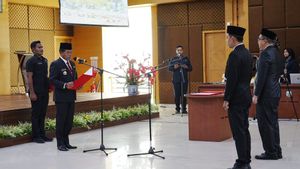JAKARTA - NASA and the National Oceanography and Atmospheric Agency (NOAA) have announced ambitious plans to face climate change challenges by innovative methods - by seeding the atmosphere with ice. This plan, which involves collaboration between these two leading research institutes, aims to reduce the amount of water vapor in the atmosphere responsible for greenhouse effects and global warming.
According to the details revealed, the method involves the use of aircraft that will fly up to 58,000 feet above Earth's surface, much higher than commercial aircraft. These planes will spray ice particles into the upper atmosphere, at an altitude of about 11 miles, with the aim of freezing water vapor before turning into greenhouse gases that accelerate global warming.
The plan has identified the right area for ice seeding, namely Western Pacific Cold Point (WCP), an Australian-sized atmospheric area. WCP was chosen because it is a place where water vapor enters the stratosphere, and by cooling the air through ice seeding, it is hoped that it can reduce the amount of water vapor that has the potential to exacerbate greenhouse effects.
In a study that supports this plan, scientists use a computer model to simulate WCP conditions. Simulation results show that by releasing two tonnes of ice particles each week, there can be a 10 percent drop in temperature in the region.
This is not something we can implement right now. It's about exploring what might be done in the future and identifying the direction of research, Joshua Schwarz, a NOAA physicist.
Schwarz noted that this effort would not eliminate the effects of carbon dioxide (CO2) and would only cool the 1/70 atmosphere which is equivalent to the amount of heat given by CO2.
Although this plan is fairly ambitious, the researchers admit that this effort will not address the root problems of climate change, namely greenhouse gas emissions such as carbon dioxide (CO2). However, they believe that this could be an additional strategy in the toolbox to tackle climate change, along with larger efforts to reduce carbon pollution.
SEE ALSO:
However, the plan also drew controversy and concern from some experts. Some scientists are concerned about the possibility of unexpected side effects or even greater negative effects as a result of a large human intervention into Earth's atmosphere.
Meanwhile, the researchers confirmed that this is the first step in exploring potential new solutions to tackle climate change, and that further studies and technology development will be needed before this plan can be implemented.
Atmospheric chemical at the Institute of Oceanography of Scrips, Lynn Russell, who was not involved in the study, said the idea was worth examining, but according to her this study did not provide many answers given all its uncertainties.
The English, Chinese, Japanese, Arabic, and French versions are automatically generated by the AI. So there may still be inaccuracies in translating, please always see Indonesian as our main language. (system supported by DigitalSiber.id)













